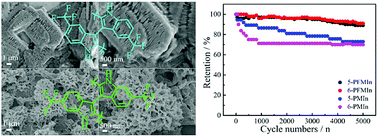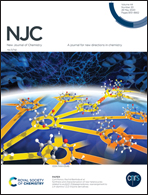Trifluoromethyl functionalized polyindoles: electrosynthesis, characterization, and improved capacitive performance†
Abstract
Fluorination of conjugated polymers has been explored as a viable strategy for enhancing the overall performance of corresponding polymers. In this work, two trifluoromethylated polyindoles (5-PFMIn and 6-PFMIn) are synthesized via simple electropolymerization and applied as energy storage materials for supercapacitors. Spectroscopic, morphological, thermal stability, and electrochemical analyses of trifluoromethylated polyindoles and their non-fluorinated counterparts (5-PMIn and 6-PMIn) are performed to reveal the significant effect of the trifluoromethyl group on the properties of polymers. Compared with non-fluorinated counterparts, 5-PFMIn and 6-PFMIn show rougher morphologies and higher thermal stabilities, and more interestingly, the fluorination of polyindoles results in substantial improvement of their electrochemical behavior. The specific capacitances of 5-PFMIn and 6-PFMIn are found to be 269 F g−1 and 296 F g−1 at 10 A g−1, respectively with excellent cycling stability of about 90% after 5000 cycles, which are superior to those of their counterparts, 5-PMIn (75 F g−1, 73%) and 6-PMIn (178 F g−1, 70%). The promising trifluoromethylated polyindoles demonstrate high potential for electrochemical capacitor application.



 Please wait while we load your content...
Please wait while we load your content...